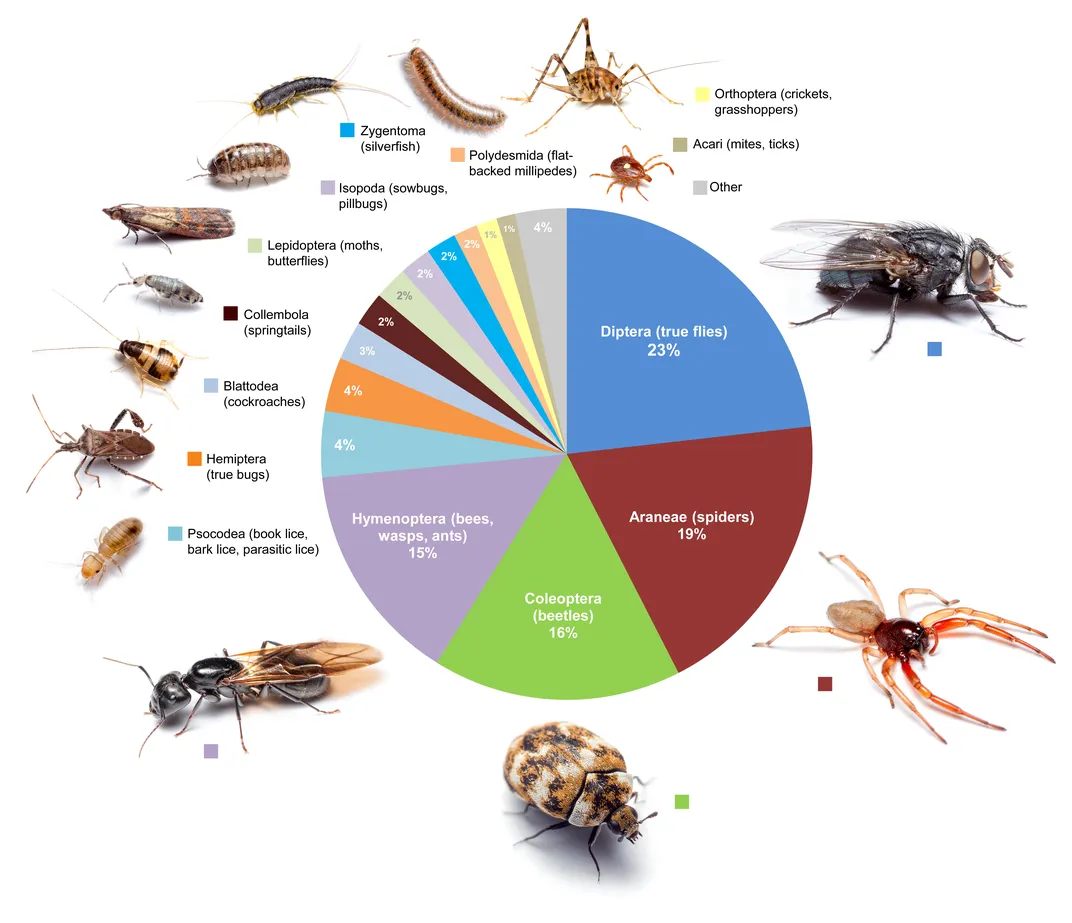Dozens of Insects and Spiders May Live in Every Room of Your House
A survey of 50 North Carolina homes turned up just five rooms that were completely free of arthropods
/https://tf-cmsv2-smithsonianmag-media.s3.amazonaws.com/filer/98/e3/98e3876e-faf1-44f9-867a-a5ce06b8572e/istock_000072832557_large.jpg)
When cockroaches infest a kitchen or bedbugs take over a mattress, human residents notice. But it turns out there are plenty of other six- and eight-legged creatures that more subtly coopt our homes.
Based on the results of a multi-home survey, our houses contain a shocking diversity of arthropods—the group of animals that includes insects, spiders and crustaceans. In some cases, more than 200 arthropod species were found in single homes.
Most household entomologists focus on pests, but the authors of the study, appearing this week in PeerJ, were interested in getting a handle on total arthropod biodiversity in our sanctum sanctorums.
“Basically, no one’s ever looked at what’s living around us,” says Matthew Bertone, an entomologist at North Carolina State University. “We explore these far-off jungles and deserts and whatnot, but people don’t focus as much on what’s in homes because they think it’s uninteresting or sterile.”
To put those assumptions to the test, Bertone and his colleagues first needed to recruit some homeowners in the Raleigh area—a task that proved surprisingly easy. After the researchers put out a call for volunteers on the news, more than 400 people got in touch within the span of a few days.
“People were almost going to pay us to come look in their homes,” Bertone says. “Some were just interested in science, some wanted us to come see what they had so they could kill it and some said, ‘My house is so clean, you’ll never find anything!’”
In the end, the researchers selected a sample of 50 random houses representing different dwelling types in the area, from new to old and small to large. A legion of entomology graduate students helped the researchers comb through each room in every home. They searched floor to ceiling, collecting a sample of every type of arthropod they came across. The only places they didn’t search were drawers and cupboards because of privacy concerns, or behind heavy furniture, for safety.
“So our estimates are probably lower than the actual diversity in homes, since there could be things hiding behind bookcases and walls,” Bertone says.
Some of the arthropods they came across were dead—creatures that had wandered in from outdoors and couldn’t survive inside. But others were alive and well when the team collected them. Rather than sample for abundance, they went for diversity. If a room contained 100 dead pillbugs (aka, rolly pollies), for example, they only collected a few specimens.
In the end they wound up with around 10,000 specimens. Out of about 550 rooms, only five—four bathrooms and a bedroom—were completely free from arthropods. Both the researchers and the homeowners were caught off guard by the sheer ubiquity and abundance of organisms.
“Homeowners were extremely surprised, and some were appalled,” Bertone says. “But basically, that surprise goes to show that arthropods really don’t bother you.”

Bertone and his colleagues then set to work identifying the species they found. Individual homes contained 32 to 211 species covering 24 to 128 arthropod families. Flies, spiders, beetles, wasps and ants made up nearly three-quarters of the average room diversity. Cobweb spiders, carpet beetles, gall midges and ants turned up in 100 percent of homes, closely followed in prevalence by book lice and dark winged fungus gnats.
“There’s a myth that says you’re never more than three feet from a spider,” Bertone says. “After finding cobweb spiders in 65 percent of rooms, I think that could be true.”
To homeowners’ relief, inconspicuous and harmless species were much more common than pests. German cockroaches occurred in just six percent of homes, while bedbugs appeared in none at all. Likewise, many homeowners expressed a fear of brown recluse spiders, but the researchers didn’t find a single one. A lone black widow turned up, tucked into a basement crawlspace.
“One message that we want to get across is that most things that are alive in our homes are fairly benign,” Bertone says.
“Urban ecology has been very neglected but we are beginning to see that species diversity in our cities is quite high and also very important,” says Michael McKinney, a professor of earth sciences at the University of Tennessee who was not involved in the research. “I think this paper is very significant—indeed, I would say cutting edge—and I hope it stimulates much further research in this area.”
The researchers have a few follow-up studies either planned or in the works. For starters, they’d like to figure out whether there are any correlations between the house, its owners’ habits and arthropod diversity. For example, will a large house in a new suburb with owners that keep the air conditioner running contain the same abundance of species as a smaller one in an older development where the owners prefer to leave the windows open?
The scientists are also interested in investigating arthropod diversity in homes outside of North Carolina and have already collected samples in San Francisco, Peru and Sweden for comparison.
For now, the researchers hope that their findings bring some Raleigh residents relief by knowing that they’re sharing their homes not with an abundance of pests but with harmless creatures that are “just living out their lives,” Bertone says.
“Some people might never get over the fact that there are things living in their homes,” he continues. “But if we can give them a little knowledge about these arthropods’ biology and point out that they’re not going to do all these horrible things, then maybe people won’t apply as many pesticides.”
/https://tf-cmsv2-smithsonianmag-media.s3.amazonaws.com/accounts/headshot/Rachel-Nuwer-240.jpg)
/https://tf-cmsv2-smithsonianmag-media.s3.amazonaws.com/accounts/headshot/Rachel-Nuwer-240.jpg)